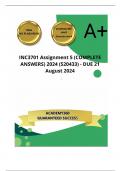,INC3701 Assignment 5 (COMPLETE ANSWERS) 2024
(520433) - DUE 21 August 2024 ; 100% TRUSTED Complete,
trusted solutions and explanations.
Question 1 1.1 As the coordinator of the school-based support
team in your school, provide a detailed explanation of inclusive
pedagogy to a newly appointed teacher. [5] 1.2 How does
inclusive pedagogy address the needs of learners who are
vulnerable to exclusion or marginalisation? Provide specific
examples. [5]
1.1 Detailed Explanation of Inclusive Pedagogy
Inclusive pedagogy is an educational approach that seeks to
address the diverse needs of all learners by creating an
environment where everyone has the opportunity to succeed. It
goes beyond merely accommodating differences and aims to
transform the teaching and learning process to benefit every
student. Key principles of inclusive pedagogy include:
1. Equity and Access: Ensuring that all learners, regardless of
their backgrounds, abilities, or learning styles, have equal
access to the curriculum and learning opportunities.
2. Differentiated Instruction: Adapting teaching methods and
materials to cater to the varied learning preferences and
needs of students. This could involve using a mix of visual,
auditory, and kinesthetic activities.
3. Universal Design for Learning (UDL): Designing
curriculum and instruction from the outset to be accessible
and effective for all students. This approach involves
providing multiple means of representation, engagement, and
expression.
, 4. Collaboration and Community: Fostering a sense of
belonging and collaboration among students and between
students and teachers. This involves creating a supportive
classroom environment where diversity is respected and
celebrated.
5. Reflective Practice: Continuously assessing and reflecting
on teaching practices to ensure they meet the needs of all
learners and making adjustments as necessary.
1.2 Addressing the Needs of Vulnerable Learners through
Inclusive Pedagogy
Inclusive pedagogy specifically addresses the needs of learners
who are vulnerable to exclusion or marginalization by
implementing strategies that recognize and accommodate their
unique challenges. Here are some specific examples:
1. Learners with Disabilities:
o Example: A student with dyslexia may struggle with
traditional reading assignments.
o Inclusive Strategy: Providing audio versions of texts,
using larger fonts, and allowing the use of text-to-
speech technology to ensure the student can access the
content in a way that suits their needs.
2. English Language Learners (ELLs):
o Example: A student whose first language is not English
may find it difficult to follow lessons and participate in
class discussions.
o Inclusive Strategy: Using visual aids, simplifying
language, providing bilingual resources, and
encouraging peer support from classmates who speak
the same language can help ELLs engage more fully in
their learning.




